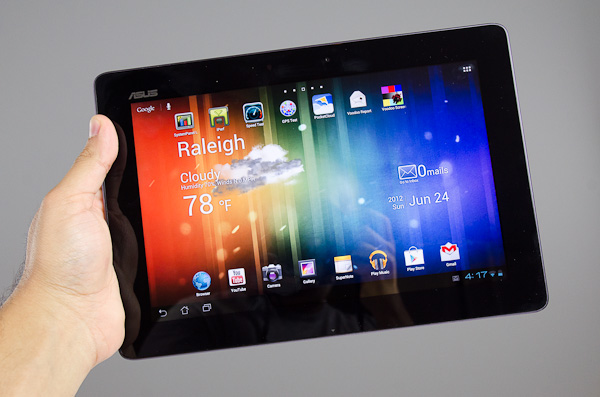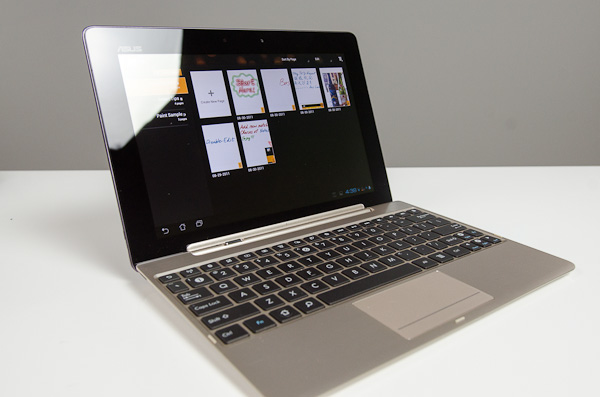ASUS Transformer Pad Infinity (TF700T) Review
by Anand Lal Shimpi on June 25, 2012 3:00 AM ESTAt Computex a few weeks ago ASUS gave us exactly what we had been hoping for: a Transformer-style tablet running Windows 8. In fact, ASUS gave us a bunch of options as far as Windows 8 tablets go. The two we've been asking for are the Tablet 600 and Tablet 810, running Windows RT and Windows 8, respectively. They feature standalone tablets with detachable keyboard/mouse docks, giving you the best of both worlds.
ASUS wasn't the only one to bring this sort of flexibility to Windows 8. Acer showed off a similar design with its Iconia W510, as did Samsung and more recently, Microsoft. With the Surface tablets Microsoft actually went a step further and tried to integrate the keyboard into a lightweight cover rather than an external dock. It remains to be seen just how well these approaches will work, but it's clear there's a trend for the first generation of Windows 8 tablets.
We can't forget however what started this all. Much like Apple with the iPhone and iPad, ASUS picked an intersection of functionality and technical feasibility with the introduction of the first Eee Pad Transformer. For the first time we had silicon capable of running for hours in a small form factor tablet, as well as a touch-enabled OS that could run on it. Previous attempts at hybrid tablets often tried to shoehorn a desktop version of Windows into a device that was too clumsy. ASUS' Transformer series was the start of something new.
Since the release of the first Eee Pad Transformer (can you believe it's only been about a year?), ASUS has released several members of the Eee Pad and Transformer families. We got a slider, a thinner version called the Transformer Prime, as well as a refreshed entry level Transformer Pad 300. ASUS' experimentation and learning will pay off later this year as it ships the first Windows RT/8 versions. Until then however ASUS isn't done iterating. Today it's officially announcing the final configuration of the Transformer Pad Infinity, the first member of the TF series with a 1920 x 1200 display. It also happens to be the first tablet we've tested to use NVIDIA's higher binned Tegra 3 T33 SoC.
| ASUS Tablet Specification Comparison | ||||||
| ASUS Eee Pad Transformer | ASUS Transformer Pad 300 Series | ASUS Eee Pad Transformer Prime | ASUS Transformer Pad Infinity | |||
| Dimensions | 271mm x 175mm x 12.95mm | 263 x 180.8 x 9.9mm | 263 x 180.8 x 8.3mm | 263 x 180.6 x 8.4mm | ||
| Chassis | Plastic | Plastic | Aluminum | Aluminum + Plastic RF Strip | ||
| Display | 10.1-inch 1280 x 800 | 10.1-inch 1280 x 800 IPS | 10.1-inch 1280 x 800 Super IPS+ | 10.1-inch 1920 x 1200 Super IPS+ | ||
| Weight | 675g | 635g | 586g | 594g | ||
| Processor | 1GHz NVIDIA Tegra 2 (2 x Cortex A9) |
NVIDIA Tegra 3 (T30L - 4 x Cortex A9) |
1.3GHz NVIDIA Tegra 3 (T30 - 4 x Cortex A9) |
1.6GHz NVIDIA Tegra 3 (T33 - 4 x Cortex A9) |
||
| Memory | 1GB | 1GB | 1GB | 1GB DDR3-1600 | ||
| Storage | 16GB + microSD card | 16GB/32GB | 32GB/64GB + microSD slot | 32/64GB + microSD slot | ||
| Battery | 24.4Whr | 22Whr | 25Whr | 25Whr | ||
| Pricing | $399 | $379/$399 | $499/$599 | $499/$599 | ||
Despite early indications of $599+ pricing, the Transformer Pad Infinity comes in at $499 for the 32GB model and $599 for 64GB. The Infinity is compatible with the Transformer Dock ($149) from the TF Prime as long as your dock has firmware 207 or later on it. The dock is what gives the Transformer Pad its name as it allows the Infinity to be converted into an Android netbook complete with QWERTY keyboard, trackpad and additional battery. The Infinity and its dock are available in the same two colors (amethyst gray and champagne gold) as the TF Prime was at launch. The Infinity dock doesn't appear to carry a separate part number, it's literally the same dock that was used with the Prime.
The chassis hasn't changed much since the introduction of the Prime. It is one-tenth of a millimeter thicker to accommodate the higher-resolution display and backlight assembly, but battery capacity remains at 25Wh. The Infinity is a little heavier and its edges are squared a bit instead of being perfectly rounded. The port configuration remains the same (micro HDMI, micro SD, headphone jack), although redistributed around the chassis. The power and volume buttons are now both located along the top of the unit, with the switches themselves more integrated with the tablet.
Although official reviews of the Infinity hit today, availability isn't scheduled until around July 16th. Quantities are unknown at this point and will likely be gated by panel availability.



















112 Comments
View All Comments
xype - Monday, June 25, 2012 - link
"The colors and brightness and contrast are better on the TFP."The colors aren’t. Neither are the ppi. Something that actually makes a real impression in most situations—unless for some reason your only usage of a tablet is in bright sunlight.
The TPI and iPad 3—as hardware, only—each have their strengths and weaknesses. To claim one is absolutely better at everything just sounds fanboi-ish. Or, you know, astroturfer-ish (which you happily accuse others of being above).
joelypolly - Monday, June 25, 2012 - link
Sounds like someone is getting paid to Asus to say these things...zappb - Monday, June 25, 2012 - link
I thought this product was Vaporware considering it was annouced around Jan...and still not released but Awesome screen all the same - Look at those Contrast / white / black level numbers, haven't seen a screen like that in years...and at 1920x1200.When you look at the numbers, the significance of the screen has been glossed over in the article, - the only reason I can see for that, is perhaps that resolution sucks on Android, or apps don't scale well etc..
Lepton87 might have a point but the overall feel of the review is to wait for windows 8 tablets when perhaps the resolution will make more sense.
Cali3350 - Monday, June 25, 2012 - link
Your being very unfair. 1920*1080 is a great resolution and a big step up. But its not 25*18. That really IS big deal, its more than most 30 inch monitors. Your trying to equate a good improvement to a complete shift. Way to be objective yourself.sawilson - Monday, June 25, 2012 - link
I own them both. I can hold them side by side. It's really hardly noticable at all until you get the tablets closer than one would use them, and once again I'm talking about the prime versus my 32gb verizon 4g iPad that work gave me. I'm happily at work now typing this on my prime because it has completely replaced my Dell laptop running windows 7. The iPad could not do this. The only reason they went with a resolution that high is they have NO CHOICE. iOS is crippled and has to use multiples of the 6 year old iphone display resolution and dimensions. That's why it has a fail 4:3 display like an old television rather than a proper 16:10 display. That's why you have to buy all new apps for it instead of the superior Android solution that mimics what your laptop or pc and mac already do. Just scale things properly. There's no such thing as a "tablet optimized" app. That's marketing. That's apple attempting to justify failure in their mobile OS design by turning it into a positive. You can tell how intelligent a tech review is by looking for terms like "tablet optimized" or "fragmented" or "retina". It means they lack the technical knowledge to understand that's just marketing meant to talk around shortcomings in their own poorly designed device.LordConrad - Monday, June 25, 2012 - link
"That's why it has a fail 4:3 display like an old television rather than a proper 16:10 display."Tablets are designed primarily as consumption devices, which is how most people use them. For such a device, I find the 4:3 aspect ratio to be superior in most respects. Internet Browsing, email, and ebooks all look much better to me on tablets with a 4:3 aspect ratio. Gaming is a wash as I don't have a preference. The only drawback is watching movies as the black bars are larger unless you zoom-in.
I have nothing against Android, I actually prefer the openness of Android, but I much prefer the paper sized 4:3 aspect ratio for handheld tablets.
Lepton87 - Monday, June 25, 2012 - link
Anand is such a huge apple fanboy and it shows in his articles but it shoudn'tJunereth - Monday, June 25, 2012 - link
were we reading the same article here?xype - Monday, June 25, 2012 - link
Probably not. Anything short of "I ONLY HAVE SEX WITH MY ANDROID TABLET FROM NOW ON!!" under Final Words is seen as definitive proof of Apple-bias by some, it seems.Cyleo - Monday, June 25, 2012 - link
Before I owned the original TF Prime I was probably inclined to agree with you. However after 6 months of use, I can see Anand's point. Where iOS is polished in almost every possible way, Android is still rough around the edges. Browser performance on Android is excellent when it works, but it also hangs a lot. Engadget for example is a website that constantly brings my TFP's browser to its knees. And I can tell you that constantly force closing your browser is pretty annoying.There is a huge potential for Android tablet, but Asus and Google need to polish the user experience if they really want to compete with Apple.